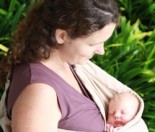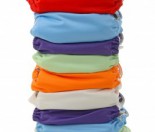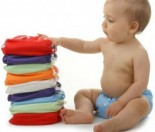For packs & slings, firstly you need to decide between a front pack, back pack or sling and then weigh up the features between different brands. This article will help you to do just that!
Front packs : Back packs : Slings : Safety note about slings : What do I need for packs and slings? : How much will packs and slings cost? : Where can I buy packs and slings? : How can I save money? : Useful articles
When you’re getting out and about with baby it’s not always practical to use a pushchair, but carrying 10kg on your hip isn’t much fun either. Back packs, front packs and baby slings all enable you to carry your baby around safely and comfortably, while still having your hands free to get on with what you are doing. Baby wearing is comfortable and convenient.
So what are your options for baby wearing?
Like anything, there are several types of packs and slings available and just which one suits you depends on your needs.
Front Packs
Front packs are designed to carry babies from birth to 12 months old. Babies can be carried facing into your chest, or facing out to see what’s going on. In either direction baby is held close to your body, with their neck and head supported. Some front packs can also be worn on the hip.
Benefits of front packs
- Can be used from birth.
- Most babies settle easily because they are close to your body.
- They are great for using around the house when you are trying to get chores done and settle baby at the same time.
- They roll away to almost nothing, so are easy to take with you when you travel or go out.
- They sit close to your body, so they are unobtrusive in crowded areas.
- Easily washed – simply throw it in the washing machine.
Cons of front packs
- Only suitable until baby is approximately 12 months old.
- Some can be tricky to strap on (especially if baby is crying and wriggly!).
For front packs, make sure you consider the following-
- Can you wear it in different positions?Most front packs can be worn with baby facing towards or away from you, but some can also be worn on the hip. Check out which positions the pack works in, and find out exactly how to wear it in each place.
- How easy is it to strap on?Trust me – there are easy versions and not-so-easy! Make sure you try it on in the shop, and then imagine trying to do it with a 12kg weight that moves.
- What type of straps does it have?Front packs put pressure on your back and shoulders, so make sure the pack has wide, padded, adjustable straps that go over your shoulders AND around your hips. Front packs without hip belts get very heavy, very fast.
- What extra features does it have?Some extra features to look out for include removable back rests, (which are great for added head support when baby is very young), adjustable seat width, (which ensures a comfortable seat as baby grows), and pockets for keeping small bits and pieces like dummies or rattles. Some may come with a waterproof cover too.
Back Packs
Back packs are designed to be used for babies that can support their head properly, and ideally should not be used until a baby is at least 9 months old. Back packs work differently to front packs in that the baby is not held close your body – instead they sit in a carrier type seat.
Benefits of back packs
- Designed to carry children up to about 3 years of age, so they have a pretty long life span.
- Originally back packs were designed for taking babies into the great outdoors, so they are modelled on tramping packs with all the necessary materials and supports.
- Usually have pockets or day bags attached so you can carry everything you need without taking an extra bag.
- Easy to put on. You simply strap in your child, and put the backpack on like any other back pack styled bag.
Cons of back packs
- Some back packs can get quite heavy, especially if you load up the bag portion as well.
- You can’t keep an eye on what your child is doing behind you. This isn’t always necessary, but in crowded areas it is nice to have an eye on the situation.
- Some back packs can be quite bulky and difficult to store or travel with.
For back packs, make sure you consider the following-
- What type of frame does it have?Make sure your back pack has a frame that allows the pack to stand unaided while you strap in your child. Even with a parent’s magical 3rd hand, it is almost impossible to hold up the pack and secure baby at the same time. Some frames also have a fold away function, which allows the pack to fold up for storage and travelling.
- How heavy is the back pack?Back packs get very heavy when you are carrying a toddler and a full bag attached. There’s no point having a heavy pack to start with, so look out for brands and styles that are lightweight.
- What type of straps does it have?Make sure your back pack has wide, well padded, adjustable shoulder straps and a waist belt with plenty of support. Don’t even think about buying a back pack without a waist belt, unless you want to spend months at the physio!
- What extra features does it have?
Foot Stirrups
These give your child somewhere to put their feet rather than just dangling down the side. It makes for a more comfortable ride and it’s better for their circulation
Sun shades / rain covers
These shades are removable and clip on to the back of your pack
Rear View Mirror
I know this sounds funny, but it’s quite handy for checking on baby when you’re out and about.
Mesh Back
When you are carrying a back pack on a hot day, it’s easy to end up with a wet sweaty back. Some brands offer a mesh back which allows air to circulate between you and the pack, making it a whole lot more comfortable for everyone.
Bags and Pockets
Check what sorts of bags and pockets are attached to the back pack. Some have day packs which can be zipped away from the pack and used as an individual bag.
Slings
Slings are fabric carriers which can be worn in a whole range of positions depending on the age, size and weight of your child, and allow you to literally ‘wear your child’. Well designed baby wearing slings can be used from birth, up until your child is about 2 years old. While slings have been around for centuries, they seem to be one of those items that Mums either love or hate. If you can find one to borrow before you buy, it might be a good idea to try it out first.
Benefits of slings
- Most babies enjoy being in a sling because they are worn close to your body and can be carried in a natural position. Slings allow babies to be cradled (unlike front packs), and therefore don’t put any pressure on their spine.
- Are great for using around the house when you’re trying to get chores done and settle baby at the same time.
- Mums can position the sling to create a private cocoon for breast feeding in public.
- Rolls up quite small, so it’s easy to store and travel with.
- Easily washed. Simply throw it in the washing machine.
Cons of slings
- Some versions can be tricky to put on.
- Rightly or wrongly, some Dads find wearing a sling unusual and prefer less ‘feminine’ carriers.
Safety Note about slings:
There has been a lot of media about slings recently as, tragically, a baby died while in a sling. There are three main safety issues related to sling use:
- The curved position can cause a baby’s head to flop forward, restricting its ability to breathe. The baby can’t cry out and can slowly suffocate.
- The baby may be smothered either by the fabric of the sling or by its parent’s clothing pressing against its nose and mouth.
- Babies can be injured by falling out of slings
Many of the deaths that have occurred in slings have been related to low birth weight babies or babies with a cold or other breathing issues and it is essential that parents check that babies can breath properly while in a sling.
The United States Consumer Product Safety Commission (CPSC) recommends:
- that parents be cautious when using slings for babies younger than four months.
- that parents should make sure the child’s face isn’t covered and that it’s visible at all times to the sling’s wearer.
- that if nursing a baby in a sling, change the baby’s position after feeding so its head is facing up and is clear of the sling and the mother’s body.
Useful websites:
http://www.consumer.org.nz/news/view/baby-sling-warning
What do I need for packs & slings?
Just what you need depends entirely on your lifestyle. If you have friends or family who can lend you a pack or sling, I suggest you make the most of it before deciding exactly what you want. It’s not something you need to rush out and buy immediately, and in fact many families cope quite nicely without a baby carrier at all. My suggestion is to settle into parenting first, and then decide what will work for you and your child as they grow.
How much will packs & slings cost?
Like anything, baby carriers vary in price depending on the brand, style and quality. Buying a front pack new will cost $50-$90, and a back pack can range anywhere between $170 and $300. There are only a few sling type carriers on the market and they range from $40-$90.
Where can I buy packs & slings from?
Front packs and back packs can be bought from most department stores and specialist baby shops, and you can also find back packs at camping and outdoor stores throughout NZ. Slings are a little harder to find, and although they are in some baby stores, the easiest way to find them is online. Our Baby Gear Suppliers list is a great place to start!
How can I save money?
Because baby carriers don’t have any specific safety features to look out for, they are one of the baby purchases you can happily make second hand. When hunting around, check the condition of any straps, buckles and clips, and make sure the general condition of the carrier is clean and tidy.
Front packs, back packs and slings can be bought through traditional second hand methods such as general second hand stores, newspapers, auction websites, and trade and exchange type publications.
Useful Articles
For information on the pros and cons of moving baby around on wheels visit Prams & Buggies.
Getting out and about? For a great checklist of what to put in Baby Bags click here.






